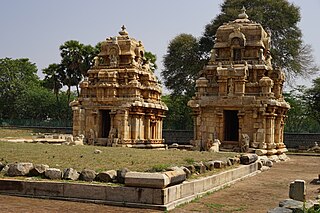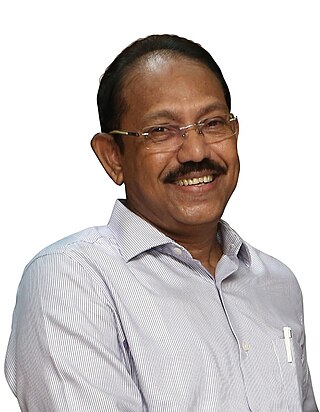Related Research Articles
Pillai or Pillay, meaning "Child of King" (Prince) or "Child", is a surname found among the Malayalam and Tamil-speaking people of India and Sri Lanka.
Kaarkaathaar is a subcaste of Vellalar Hindu caste in the Indian state of Tamil Nadu.
Mudaliar is a Tamil title and surname. As title, it was historically given to high-ranking officers, administrators and their descendants during the rule of Imperial Cholas. The surname is most prevalent among Tamils from Tamil Nadu and Sri Lanka. Descendants of Tamil migrants also bears variants of the name in countries such as South Africa, and elsewhere in the Tamil diaspora. List of Mudaliars

The Balai, Raj Balai, BalahiBunkar, or Sutarkar are found in the states of Madhya Pradesh, Rajasthan, Punjab, Maharashtra, Delhi and Uttar Pradesh in India.
Vellalar is a group of castes in the Indian states of Tamil Nadu, Kerala and northeastern parts of Sri Lanka. The Vellalar are members of several endogamous castes such as the numerically strong Arunattu Vellalar, Chozhia Vellalar, Karkarthar Vellalar, Kongu Vellalar, Thuluva Vellalar and Sri Lankan Vellalar.
Kongu Vellalar is a community found in the Kongu region of Tamil Nadu, India.
Thuluva Vellalar, also known as Agamudaya Mudaliar or Arcot Mudaliars, is a caste found in northern Tamil Nadu, southern Andhra Pradesh and southern Karnataka. They were originally significant landowners.

Vallicode-Kottayam is a village in Pathanamthitta district in the state of Kerala, India. Vallicode-Kottayam village is a part of Konni Taluk, District of Kerala State, India.

S. Abdul Hameed known by his pen name Manushya Puthiran is a poet and writer from Tamil Nadu, India.

Irunkōvēl, also known as Irungkōvēl, Irukkuvēl, and Ilangōvēlir, was a title of the Irunkōvēl line of Velir kings. The Irunkovel line of kings ruled over Konadu identified with the Kodumbalur and surrounding areas in ancient Tamilakkam. They trace their lineage to the clan of Krishna; one of the inscriptions at Kodumbalur belonging to one of the kings in the Irunkovel line, namely Tennavan Irunkōvēl alias Maravan Bhutiyar. They belong to Kallar family, K. A. Nilakanta Sastri mentions in his study.

Nanjil Nadan is the pseudonym of G. Subramaniam, a Sahitya academy winning Tamil writer from Tamil Nadu, India.
Vadapadimangalam estate was a mirasdari estate in the Tiruvarur district of Tamil Nadu, India. It was owned by a Mudaliar family of the Vellalar caste. The estate originated as a grant of land to the family who operated as Pattakdars or revenue collectors on behalf of the Thanjavur Maratha ruler Thuljaji.
Kunniyur estate was a mirasdari estate in the Tiruvarur district of Tamil Nadu, India. Previously located in Tanjore district, it was one of the four great feudal estates of the Cauvery Delta. Headquartered in the town of Kunniyur, the "mirasdari" covered more than 6000 acres.
Sirumalaikottai is a village panchayat in Tamil Nadu, India. It is located in Ramanathapuram district, Thiruvadanai Taluk. The nearest towns are Devakottai, Karaikudi, and Thiruvadanai.

M. Rajendran served as Vice-Chancellor of Tamil University, Thanjavur, in Tamil Nadu, India. He is a Tamil Scholar, Writer and Publisher of Kanaiyazhi literary magazine in Tamil., He was the coordinator of academic committee, World Classical Tamil Conference 2010. He chaired the High Level Committee to amend the Tamil Nadu Public Library Act and Tamil Nadu Public Library Rules, which was constituted by the Government of Tamil Nadu in January 2022. Kalingar Mu. Karunanidhi Classic Tamil Award, Muthamilkavalar Ki.Aa.Be. Vishwanatham Award has been given to him.
Isai Vellalars are a micro community. Out of all the divisions, Melakkarars are the predominant Isai Vellalars. Edgar Thurston noted that the community had two linguistic sects within the state; being Tamil and Telugu. Tamil-speaking Melakkarars traditionally performed both ‘Chinna Melam’(nautch music) and/or ‘Periya Melam’(nadaswaram), while Telugu-speaking Melakkarars of Tamilnadu performed only ‘Periya Melam.’ Telugu Melakkarars had surname like ‘Reddi’ and ‘Naidu’, while the Tamil sect used ‘Pillai’ title.The former speak Tamil, and, in most of their custom.In customs and practices Telugu Chinna Melam is alike to that of Telugu Brahmins. There are also other sects like Nattuvanar, barber-musicians, etc. under Isai Vellalar label. Some from this community were made devadasis until its abolition.
Thondaimandala Vellalar is a high-ranking subcaste of the Vellalar caste in the state of Tamil Nadu, India who tend, to adopt the title of Mudaliar and they were traditional "landlords and officials of the state class" described by the anthropologist Kathleen Gough. They are a closely knit community and follow the Vegetarian diet. Thondaimandalam Mudaliars / Vellalars are progressive and prosperous in the society and they are remarkably advanced in the matter of education
Kondaikatti Velaalar or Thondaimandala Mudaliar is a Tamil caste in south India. Historically, they were a caste of non-cultivating land-holders and some of them were administrators under various south Indian dynasties. Their original homeland was Thondaimandalam and from there they spread to other areas in south India and northeastern parts of Sri Lanka. Since they historically used the Mudaliar title, they are sometimes referred to as Thondaimandala Mudaliar. However, Kathleen Gough considers them to be a separate subcaste of the Thondaimandala Mudali, as does Susan Neild.
Kasiviswanathar Temple is a historical Hindu temple dedicated to Lord Shiva, situated in Walajapet neighbourhood, Ranipet in the state of Tamil Nadu in the peninsular India. This temple is built around 300 years ago.
References
- 1 2 Gough, Kathleen (2008-01-03). Rural Society in Southeast India. Cambridge University Press. ISBN 978-0-521-04019-8.
- 1 2 Wink, André (2002). Al-Hind, the Making of the Indo-Islamic World: Early Medieval India and the Expansion of Islam 7Th-11th Centuries. BRILL. ISBN 978-0-391-04173-8.
- 1 2 ":: TVU ::". www.tamilvu.org. Retrieved 2023-11-19.
- 1 2 Thurston, Edgar (1909). Castes And Tribes Of Southern India Vol.7 (t-z).
- ↑ Dev Nathan (1997). From Tribe to Caste. Indian Institute of Advanced Study. p. 233.
- ↑ Venkatasubramanian, T. K. (1993). Societas to Civitas: Evolution of Political Society in South India : Pre-Pallavan Tamil̤akam. Kalinga Publications. ISBN 978-81-85163-42-0.
- 1 2 "Vellala | Encyclopedia.com". www.encyclopedia.com. Retrieved 2023-09-27.
- 1 2 A page no.1069 from the book "Abidhana Chintamani" written by Singharavelu Mudaliar.
- ↑ https://ta.wiktionary.org/wiki/%E0%AE%B5%E0%AF%86%E0%AE%B3%E0%AF%8D%E0%AE%B3%E0%AE%BE%E0%AE%9F%E0%AF%8D%E0%AE%9F%E0%AE%BF.
- 1 2 தேவநேயன், ஞாநமுத்தன் (2000). தமிழர் வரலாறு (in Tamil). தமிழ்மண் பதிப்பகம்.
- ↑ André Wink (2002). Al-Hind: Early medieval India and the expansion of Islam, 7th-11th centuries. Brill Academic Publishers. p. 321. ISBN 90-04-09249-8.
Not only were the Vellalas the landowning communities of South India,...
- 1 2 Gough, Kathleen (2008). Rural Society in Southeast India. Cambridge University Press. p. 29. ISBN 978-0-521-04019-8.